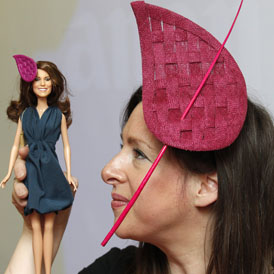British fashion industry on parade
Culture Editor Matthew Cain on the unprecedented shop window the royal nuptials offer to British designers hoping to impress the estimated two billion tuning in for the Royal Wedding.

As well as the royal wedding, something else is going to be happening on April 29th. And for many of the projected two billion viewers around the world this something else is going to overwhelm even the wedding itself…
Two weeks today in Westminster Abbey, the whole world is going to be treated to a celebration of British fashion. You could even argue that this will be almost as important for Britain and our image around the world as the actual wedding.
Like our food and weather, British fashion used to be something of a joke, particularly for Europeans. But, like our food, this has all changed. The weather we’re still waiting on. But in the meantime, the royal wedding will give us a chance to show off our recent fashion successes for the whole world to see.
Because over the last two decades, British fashion has really come into its own. In the 60s and 70s we always had one or two great designers doing their thing – Mary Quant, Zandra Rhodes and Vivienne Westwood spring to mind. But in the 90s and 00s this blossomed into a whole industry with a much more solid infrastructure led by high profile designers such as Stella McCartney, John Galliano, Alexander McQueen, Christopher Bailey, Philip Treacy, Julien Macdonald and Paul Smith – many of whom have spent long periods heading up fashion houses abroad.
Of course, this relatively new British fashion industry comes together twice a year at London Fashion Week. It used to be case that London Fashion Week was where the army of international fashionistas would pop in for quirky, off-piste experimental work in between doing the serious business at New York, Paris and Milan. But British fashion has since become a powerhouse of creativity and commerce serving all ends of the fashion market. According to recent estimates, the fashion industry contributes £21 billion a year to British economy. No doubt this figure will rise after the royal wedding – effectively the biggest ever catwalk show for British fashion.
And, like many people around the world, I can’t wait to see what the guests at the wedding choose to wear. Because for me, fashion isn’t just a flightly bit of fun, it’s a means of self-expression and even self-actualisation. What we choose to wear not only makes a statement about how we feel about ourselves but it’s also a tool which allows us to project these feelings to the outside world. We can all remember Elizabeth Hurley in the Versace safety pin dress which introduced her to the world and made her famous. The Spice Girls used fashion both on-stage and off as a means of establishing their personalities in the public imagination and then living up to their prescribed nicknames. More recently, Gwyneth Paltrow’s post-babies red carpet re-launch made headlines around the world by blowing out of the water the frumpy, mumsy image which had begun to haunt her and even affect her career. It’s clear to me at least that our choice of clothes is not only a means of expressing our own personality but also of changing the way other people think about us and understand our very identity. And not just for celebrities – but for all of us.
Which is why on royal wedding day the stakes are high not just for the bride herself but also for several of the high profile guests. What will a heavily pregnant Victoria Beckham wear after years of working hard to establish herself as someone who deserves to be taken seriously? After decades of unfavourable comparisons to the fashion-conscious Princess Diana, will Camilla lay to rest the ghost of her horsey, unstylish past? And will Princesses Beatrice and Eugenie emerge as fashion icons of the future or repeat the mistakes of their mother, whose popularity began to crumble following a series of unfortunate fashion faux-pas in the 80s?
We’ll have to wait until April 29th to find out the answers to these questions and a lot more. But for the time being, one thing at least looks certain. With unprecedented interest from the international media, the royal wedding will drive the final nail into the coffin of the view that British fashion is anything other than world-leading. If the estimated global audience of 2 billion actually materialises, then what the wedding can achieve is virtually limitless. Who knows? If the sun’s shining, it might even change the commonly-held view of Britain as the home of bad weather. Unfortunately, changing the weather itself might be a little too much to ask.
Read more from Matthew Cain and have your say on the Culture Blog